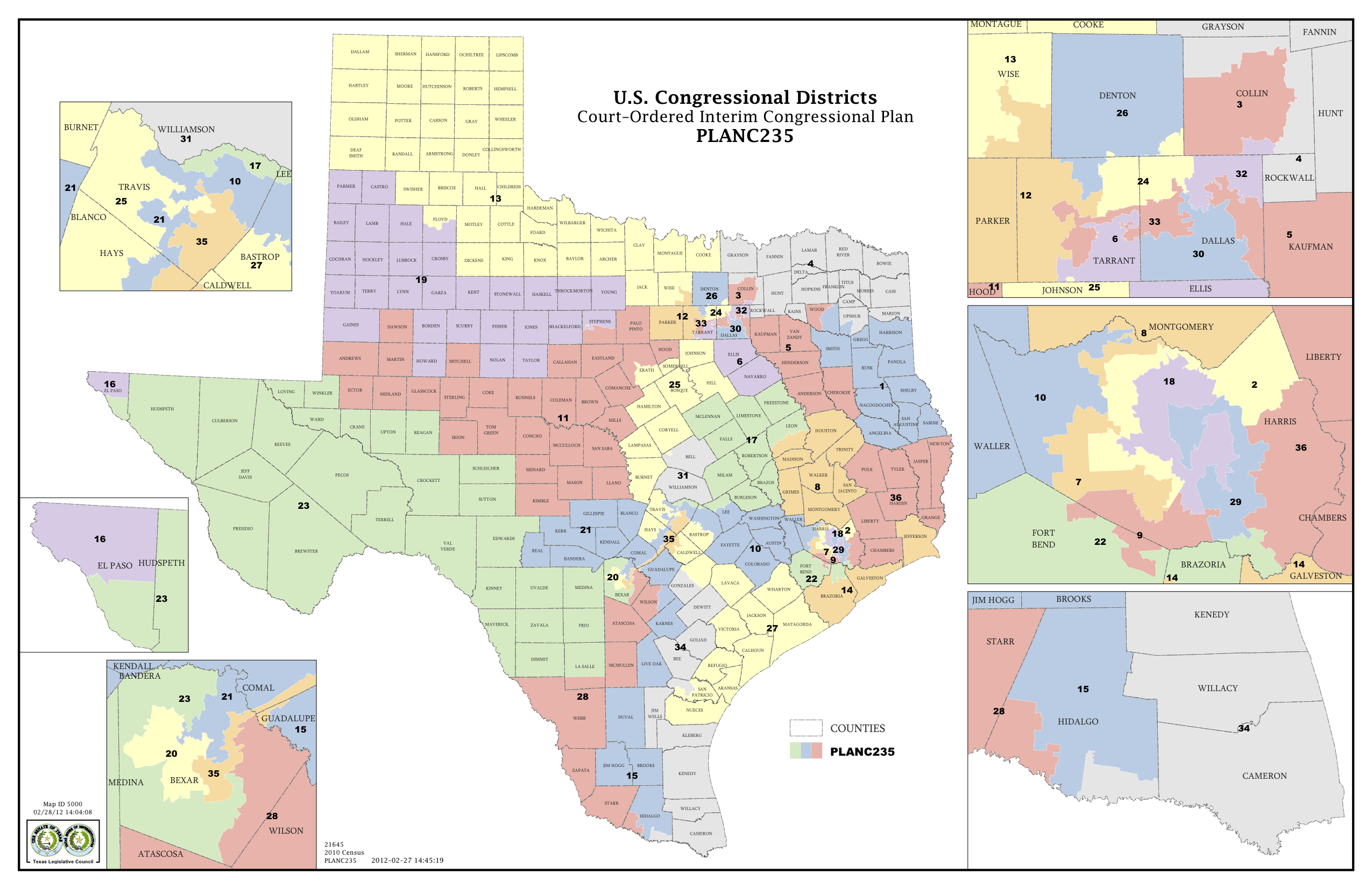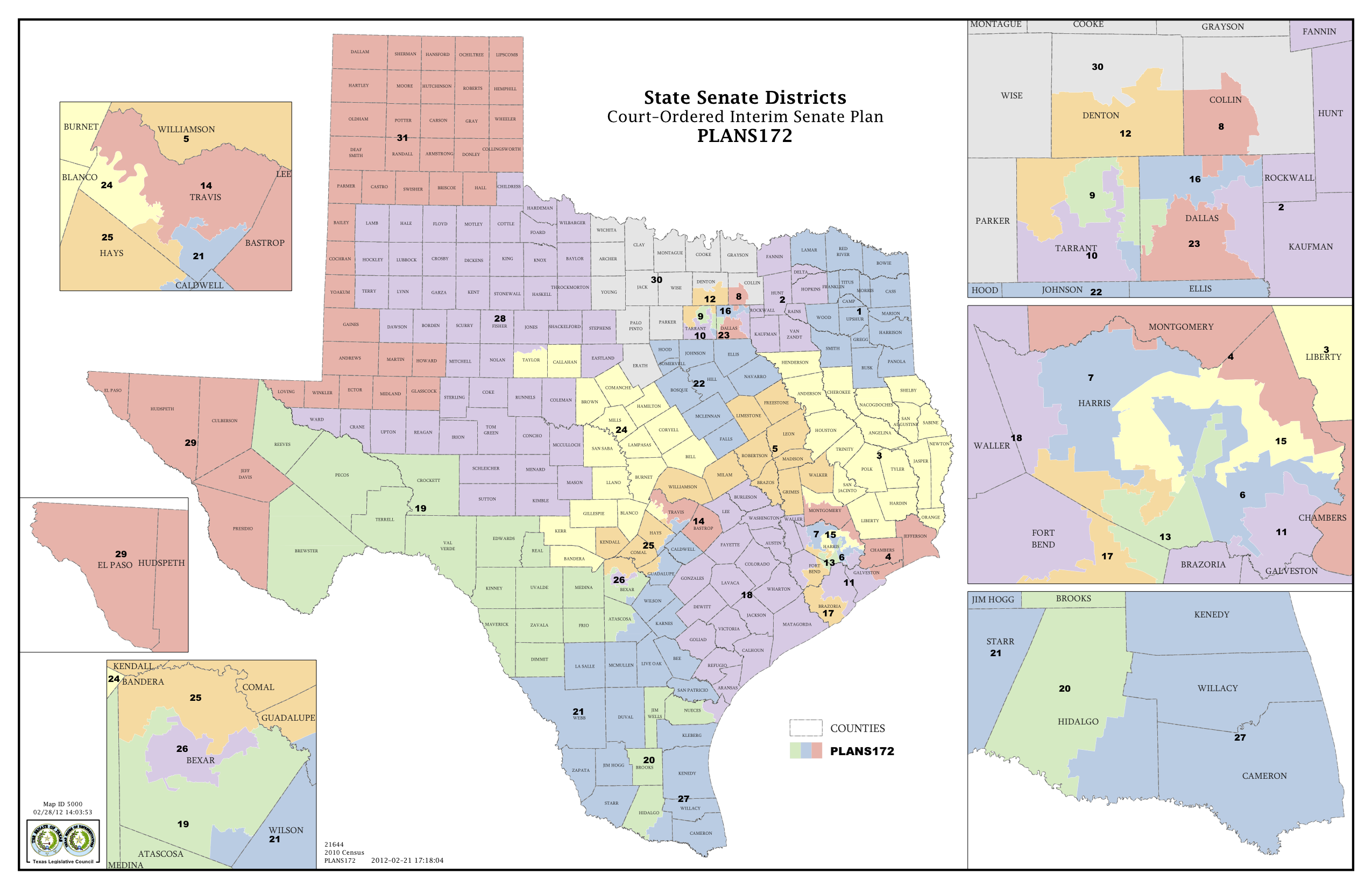Court Delivers Maps for Texas House, Congress
/https://static.texastribune.org/media/images/HandsOnRedistricting.jpg)
Now there are maps.
Federal judges in San Antonio unveiled maps for the state's congressional delegation and for the state House this afternoon, and they did it in time to allow the state to hold its delayed political primaries on May 29. The court also signed off on Senate plans agreed to earlier this month.
The court has not ordered a May 29 election, but on Monday it asked the political parties to detail the election law waivers they would need in order to hold their primaries on that date. The judges put out the maps early enough to take comments from the various parties on them, but they didn't immediately seek those comments, and aren't required to do so.
Attorney General Greg Abbott said these maps are much closer to those originally approved by the Texas Legislature last year. "I consider these interim maps to be a substantial improvement over the maps previously issued by the San Antonio court," he said. "The court properly rejected demands by some plaintiffs to draw drastic and over-reaching maps."
The state objected to the court's first maps because the judges started their drawings from the current political maps instead of starting with the maps approved by the Legislature last year. The U.S. Supreme Court kicked those back, telling the Texas judges to start from the Legislature's work, correcting for violations of the Constitution and the federal Voting Rights Act.
Gov. Rick Perry blamed the judges for the delay in the state's primary elections. "As the Supreme Court has agreed, the federal court in San Antonio overstepped its boundaries when it took it upon itself to draw new maps," he said in a press release. "Had the federal court done it correctly to begin with, the time, costs and inconvenience to our state could have been avoided, and we would be having our elections on schedule."
The Texas Democratic Party didn't like the results. "We appreciate the court’s efforts, but their maps are far from accurate representation," said spokeswoman Rebecca Acuña. "These maps may be slightly better than those passed by a radical legislature but they still grossly misrepresent the demographics of our state. The Texas Democratic Party will continue to support our allies who are fighting to ensure that all communities are accurately represented."
But at least one of the groups that sued the state was happy with the congressional plans, even though an incumbent Democrat from Austin was pinched in the process.
"The interim congressional redistricting plan complies with the mandates of the Voting Rights Act by creating two additional Latino-majority congressional districts," said Nina Perales, MALDEF vice president of litigation and lead counsel for the Texas Latino Redistricting Task Force, a coalition pushing for more Hispanic clout. "Therefore, this litigation has achieved what the state of Texas failed to include in its legislatively enacted congressional redistricting plan — districts that recognize the significant population growth of Latinos in Texas."
The new maps for the Texas House, for example, are apparently identical in Dallas and Tarrant counties to those drawn by lawmakers. In the Senate map, the only changes are the ones made after the state agreed to restore a Tarrant County district to the way it is now.
Here is a link to the congressional map on the Texas Legislative Council's redistricting website.
Here is a link to the House map on TLC's website.
Here is a link to the Senate map on TLC's website.
And here (courtesy of TxRedistricting.org) are links to the court's orders on the three maps: Congress, House and Senate.
Barring appeals, these maps will be used for the 2012 elections. Below are the new maps, along with some details about each.
• No incumbent members of Congress were paired in the court map.
• In 2008, Republican John McCain got more than 50 percent of the vote in 24 of the 36 congressional districts. The current delegation has 32 members; 23 of them are Republicans.
• The map puts incumbent Rep. Lloyd Doggett, D-Austin, in a Republican district — like the one drawn for him by the Legislature — that stretches from the southern border of Tarrant County, on the north, to include much of Hays County, south of Austin.
Doggett immediately announced he will file in the new Congressional District 35, which stretches from Austin to San Antonio. He has already set up a fundraiser at a supporter's home in San Antonio. "As an effective advocate for schools, veterans, health care and retirement security, my service fits well with the neighborhoods that have now been joined from South San Antonio to North Austin," he said in a news release. "I will continue the visits with working families that I already have under way. And I will continue to stand up to Rick Perry and other extremists, whose misguided policies are threatening our families' security."
• The newly created Congressional District 33 in Dallas and Tarrant counties voted strongly for Barack Obama in the 2008 election, and Anglos account for less than 20 percent of the voting age population. Hispanics account for 61.3 percent of the voting age population in that district.
• U.S. Rep. Blake Farenthold, R-Corpus Christi, will be in a district that reaches up the coastline to Matagorda County and inland almost to the Travis County line. But that's still a Republican district, according to the McCain-Obama numbers from 2008.
• According to the state's lawyers, CD-23, which stretches from El Paso to San Antonio, is now back to what the Legislature drew. It's got a Republican incumbent — Francisco "Quico" Canseco of San Antonio — but McCain lost narrowly in the district in 2008. Canseco didn't outright endorse the map, but he's glad the waiting is over. "I am hopeful that this process is finally coming to an end," Canseco said in a press release. "It has been a long road to get here, but in the end we finally have a map that is fair for voters across Texas and we can look forward to the scheduling of elections. In this Presidential election year, it is well past time that Texans know when their voices will be heard in choosing candidates and nominees."
• Republican John McCain carried 97 of the 150 House districts in the 2008 presidential election.
• Several Texas House members were paired, including Erwin Cain and Dan Flynn; Mike "Tuffy" Hamilton and Allan Ritter; Connie Scott and Raul Torres; Jose Aliseda and J.M. Lozano; Warren Chisum and Jim Landtroop; Rodney Anderson and Linda Harper-Brown; Cindy Burkett and Joe Driver; and Jim Murphy and Beverly Woolley.
Most of those are empty challenges. Scott and Torres are both planning to run, but in each of the other pairings, one of the candidates is either retiring, moving to another district or running for another office.
One pairing from the court's original plan is notably missing from this one: Geannie Morrison of Victoria and Todd Hunter of Corpus Christi, both Republicans, are no longer in the same district.
The Senate maps are very close to those drawn by the Legislature, with changes made in Tarrant County after an agreement between the state and lawyers for Sen. Wendy Davis, D-Fort Worth, among others. She'll have a district much like the one she has now: It votes Republican most of the time, with her 2008 win a notable exception.
• Republican John McCain carried 20 of the 31 districts in the Senate map (including Davis' Senate District 10) in the 2008 presidential election.
Texas Tribune donors or members may be quoted or mentioned in our stories, or may be the subject of them. For a complete list of contributors, click here.
Information about the authors
Learn about The Texas Tribune’s policies, including our partnership with The Trust Project to increase transparency in news.



/https://static.texastribune.org/media/profiles/ramsey-ross_TT.jpg)